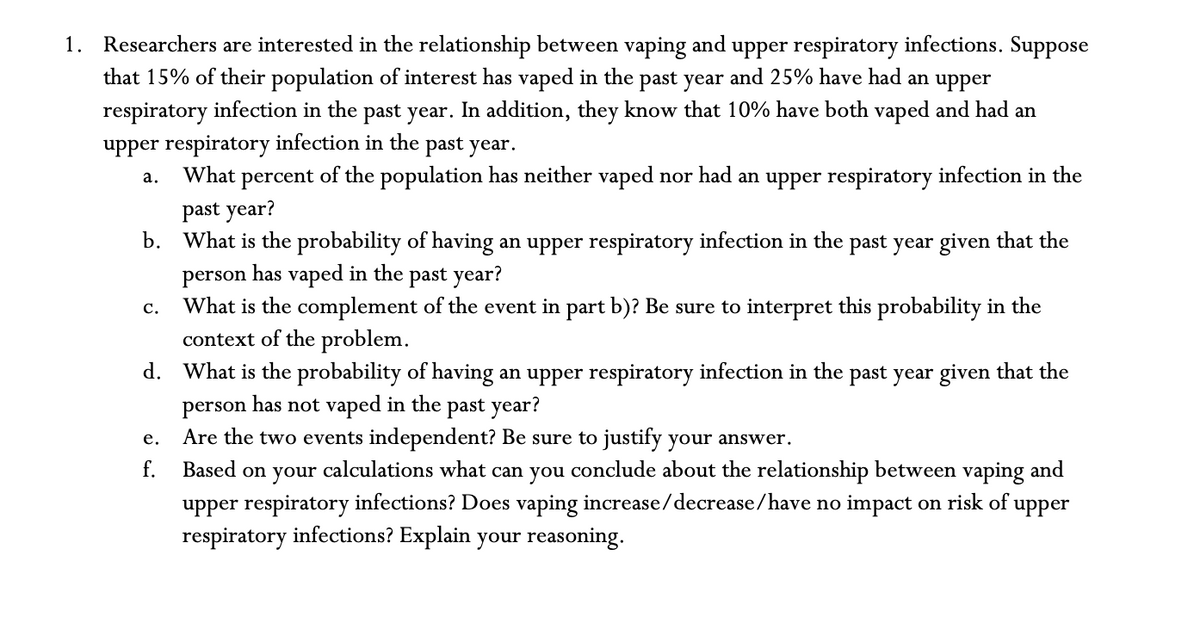1. Researchers are interested in the relationship between vaping and upper respiratory infections. Suppose that 15% of their population of interest has vaped in the past year and 25% have had an upper respiratory infection in the past year. In addition, they know that 10% have both vaped and had an upper respiratory infection in the past year. a. What percent of the population has neither vaped nor had an upper respiratory infection in the past year? b. What is the probability of having an upper respiratory infection in the past year given that the person has vaped in the past year? What is the complement of the event in part b)? Be sure to interpret this probability in the context of the problem. C.
1. Researchers are interested in the relationship between vaping and upper respiratory infections. Suppose that 15% of their population of interest has vaped in the past year and 25% have had an upper respiratory infection in the past year. In addition, they know that 10% have both vaped and had an upper respiratory infection in the past year. a. What percent of the population has neither vaped nor had an upper respiratory infection in the past year? b. What is the probability of having an upper respiratory infection in the past year given that the person has vaped in the past year? What is the complement of the event in part b)? Be sure to interpret this probability in the context of the problem. C.
A First Course in Probability (10th Edition)
10th Edition
ISBN:9780134753119
Author:Sheldon Ross
Publisher:Sheldon Ross
Chapter1: Combinatorial Analysis
Section: Chapter Questions
Problem 1.1P: a. How many different 7-place license plates are possible if the first 2 places are for letters and...
Related questions
Question

Transcribed Image Text:1. Researchers are interested in the relationship between vaping and upper respiratory infections. Suppose
that 15% of their population of interest has vaped in the past year and 25% have had an upper
respiratory infection in the past year. In addition, they know that 10% have both vaped and had an
upper respiratory infection in the past year.
What percent of the population has neither vaped nor had an upper respiratory infection in the
past year?
b. What is the probability of having an upper respiratory infection in the past year given that the
person has vaped in the past year?
What is the complement of the event in part b)? Be sure to interpret this probability in the
context of the problem.
a.
C.
d. What is the probability of having an upper respiratory infection in the past year given that the
person has not vaped in the past year?
Are the two events independent? Be sure to justify your answer.
Based on your calculations what can you conclude about the relationship between vaping and
upper respiratory infections? Does vaping increase/decrease/have no impact on risk of upper
respiratory infections? Explain your reasoning.
e.
f.
Expert Solution
This question has been solved!
Explore an expertly crafted, step-by-step solution for a thorough understanding of key concepts.
This is a popular solution!
Trending now
This is a popular solution!
Step by step
Solved in 4 steps

Recommended textbooks for you

A First Course in Probability (10th Edition)
Probability
ISBN:
9780134753119
Author:
Sheldon Ross
Publisher:
PEARSON


A First Course in Probability (10th Edition)
Probability
ISBN:
9780134753119
Author:
Sheldon Ross
Publisher:
PEARSON
